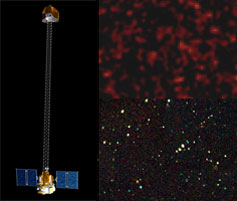
Handy Links
SLAC News Center
SLAC Today
- Subscribe
- Archives: Feb 2006-May 20, 2011
- Archives: May 23, 2011 and later
- Submit Feedback or Story Ideas
- About SLAC Today
SLAC News
Lab News
- Interactions
- Lightsources.org
- ILC NewsLine
- Int'l Science Grid This Week
- Fermilab Today
- Berkeley Lab News
- @brookhaven TODAY
- DOE Pulse
- CERN Courier
- DESY inForm
- US / LHC
SLAC Links
- Emergency
- Safety
- Policy Repository
- Site Entry Form

- Site Maps
- M & O Review
- Computing Status & Calendar
- SLAC Colloquium
- SLACspeak
- SLACspace
- SLAC Logo
- Café Menu
- Flea Market
- Web E-mail
- Marguerite Shuttle
- Discount Commuter Passes
-
Award Reporting Form
- SPIRES
- SciDoc
- Activity Groups
- Library
Stanford
Around the Bay
NASA Restarts Telescope Mission to Detect Black Holes
 NASA has made a decision to restart an astronomy mission that will have greater capability than any existing instrument for detecting black holes in the local universe.
NASA has made a decision to restart an astronomy mission that will have greater capability than any existing instrument for detecting black holes in the local universe.
The Nuclear Spectroscopic Telescope Array, or NuSTAR, is a telescope capable of imaging celestial X-rays in the range of 10 - 80 keV, known as the "hard" X-ray band. Data from NuSTAR will expand our understanding of the origins and destinies of stars and galaxies. NASA had stopped the study effort on the NuSTAR mission in 2006 due to funding pressures within the Science Mission Directorate.
"We are very excited to be able restart the NuSTAR mission," said Alan Stern, associate administrator for the Science Mission Directorate at NASA Headquarters in Washington. "NuSTAR has more than 500 times the sensitivity of previous instruments that detect black holes. It's a great opportunity for us to explore an important astronomical frontier. We are getting more and more from the science budget we have, and the restart of the highly-valued NuSTAR mission is an example of that."
SLAC's main role in NuSTAR is scientific guidance and collaboration on the interpretation and analysis of data, but is likely to involve instrument calibration. "Those of us working on this project had not lost hope for this really wonderful mission," said Kavli Institute for Particle Astrophysics and Cosmology (KIPAC) researcher Greg Madejski, a NuSTAR co-investigator who has been working on the mission since its infancy stages. "Due to the merits of this mission, it is back up and running."
Said KIPAC Director Roger Blandford, "Kudos to NASA's Science Mission Directorate for taking the correct decision. I am delighted that my colleagues at Stanford are collaborating with my former colleagues at Caltech on such an exciting and timely mission."
With an expected 2011 launch, the spacecraft will map areas of the sky that radiate high-energy X-rays and complement astrophysics missions that explore the cosmos in other regions of the electromagnetic spectrum. "The decision is very timely, since joint observations with the Large Area Telescope on-board the gamma-ray observatory GLAST—which will be launched next year—will be particularly valuable toward understanding the most extreme cosmic particle accelerators producing gamma-rays," said Madejski.
"NuSTAR will perform deep observations in hard X-rays to detect black holes of all sizes and other exotic phenomena," said Jon Morse, director of the Astrophysics Division at NASA Headquarters.
NuSTAR is a part of NASA's Explorer Program, which seeks to provide frequent, low-cost access to space. NuSTAR originally was selected from proposals submitted in response to an announcement of opportunity in 2003. Fiona Harrison of the California Institute of Technology, Pasadena, is the mission's principal investigator. NASA's Jet Propulsion Laboratory (JPL) in Pasadena, California, manages the NuSTAR mission, which brings together collaborators from Caltech, SLAC/KIPAC, JPL, Columbia University, Lawrence Livermore National Laboratory, U.C. Santa Cruz, Sonoma State University, and the Danish Space Research Institute.
NASA expects to select three additional Small Explorer missions for flight in the first half of the next decade through a competitive selection within the astrophysics and heliophysics scientific communities.
—Fiona Harrison and Kelen Tuttle, SLAC Today, October 2, 2007
Above image: NuSTAR (left) will provide images of the sky in the band encompassing 10-80 keV (simulated observations at bottom) more than 500 times more sensitive than previous observations (top image).